

 |
Search the Site with

|
 | 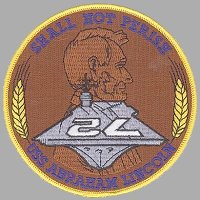 |  |
USS ABRAHAM LINCOLN is the fifth ship in the NIMITZ - class of nuclear powered aircraft carriers.
| General Characteristics: | Keel Laid: Nov. 3, 1984 |
| Launched: Feb. 13, 1988 | |
| Commissioned: Nov. 11, 1989 | |
| Builder: Newport News Shipbuilding Co., Newport News, Va. | |
| Propulsion system: two nuclear reactors | |
| Main Engines: four | |
| Propellers: four | |
| Blades on each Propeller: five | |
| Aircraft elevators: four | |
| Catapults: four | |
| Arresting gear cables: four | |
| Length, overall: 1092 feet (332,85 meters) | |
| Flight Deck Width: 257 feet (78,34 meters) | |
| Area of flight deck: about 4,5 acres | |
| Beam: 134 feet (40,84 meters) | |
| Draft: 38,4 feet (11,7 meters) | |
| Displacement: approx. 100,000 tons full load | |
| Speed: 30+ knots | |
| Planes: approx. 85 | |
| Crew: Ship: approx. 3,200 Air Wing: 2,480 | |
| Armament: two Mk-57 Mod 3 Sea Sparrow launchers, three | |
| Homeport: San Diego, Calif. |
Crew List:
This section contains the names of sailors who served aboard USS ABRAHAM LINCOLN. It is no official listing but contains the names of sailors who submitted their information.
USS ABRAHAM LINCOLN Cruise Books:
Notes of Interest:
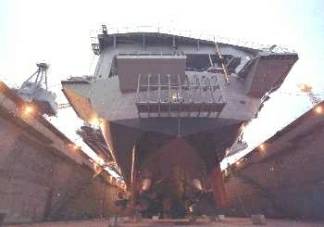

About the Carrier's Name, about Abraham Lincoln:
 Abraham Lincoln - born on 12 February 1809 near Hodgenville, Ky. - lived in Kentucky until the age of seven. At that time, his family moved to southwestern Indiana where they lived until 1830. During the sojourn in Indiana, Lincoln made a trip down the Mississippi to New Orleans, La., that probably provided his first face to face confrontation with slavery as an adult. In 1830, Lincoln moved to Illinois with his father's family but struck out on his own the following year. He hired on for another flatboat trip to New Orleans, and, upon his return, the promoter offered him a job in his store and mill in New Salem, Ill. Unfortunately, both businesses failed within the year. At the time when Lincoln's livelihood became precarious, Chief Black Hawk and his Sac Indians had the impertinence to try to take Illinois back from the white man. Lincoln joined the local militia company, and his personal popularity won him election to the office of captain. His lone opportunity for military distinction came to naught, however, for, to paraphrase his own words, all he ever chanced to fight were mosquitoes.
Abraham Lincoln - born on 12 February 1809 near Hodgenville, Ky. - lived in Kentucky until the age of seven. At that time, his family moved to southwestern Indiana where they lived until 1830. During the sojourn in Indiana, Lincoln made a trip down the Mississippi to New Orleans, La., that probably provided his first face to face confrontation with slavery as an adult. In 1830, Lincoln moved to Illinois with his father's family but struck out on his own the following year. He hired on for another flatboat trip to New Orleans, and, upon his return, the promoter offered him a job in his store and mill in New Salem, Ill. Unfortunately, both businesses failed within the year. At the time when Lincoln's livelihood became precarious, Chief Black Hawk and his Sac Indians had the impertinence to try to take Illinois back from the white man. Lincoln joined the local militia company, and his personal popularity won him election to the office of captain. His lone opportunity for military distinction came to naught, however, for, to paraphrase his own words, all he ever chanced to fight were mosquitoes.
Returning to New Salem, Lincoln tried his hand at a succession of occupations - among them postmaster, surveyor, and store owner - before settling upon the unlikely choice of law. Unlikely because he had only about a year of formal schooling to his credit. On the other hand, as a youth he had learned to read, write, and to do arithmetic and had become an avid reader. In addition, the study of law in the early 19th century could be rather informal in general, and admission to the bar on the frontier was even more so. In any event, he obtained his license to practice law on 9 September 1836 and, the following year, moved to Springfield, Ill., where he became partner to his friend and legal and political mentor, John T. Stuart.
His interest in politics actually predated his legal career and, to a great extent, provided the impetus to it. He made an unsuccessful bid for a seat in the state legislature soon after his return from the Black Hawk War. In 1834, however, his efforts succeeded, and he was reelected in 1836, 1838, and 1840. Active in the state Whig leadership, he was the party's candidate for speaker twice and, though defeated, served effectively as the party's floor leader. It was during this period of his life that Lincoln's misgivings about the institution of slavery took on more concrete form, and, though he lacked the fanatical zeal of the Abolitionists, Lincoln became a determined antislaver. In 1846, Lincoln ran for the United States House of Representatives and defeated his Democratic opponent. Peter Cartwright, handily. In Congress, he opposed the war with Mexico but recognized the need for unity in its prosecution and so voted for the appropriations needed to carry it out successfully. Interestingly enough, his principles with regard to the Mexican War cost Lincoln reelection in 1848. The war was very popular with the frontiersmen who had sent him to Washington.
 He worked long and hard for the Whig candidate. General Zachary Taylor, during the election of 1848. When Taylor took office, however, his administration balked at making Lincoln commissioner of the General Land Office, an appointment he earnestly desired. Refusing less prominent offices in the Oregon territory, he returned to Illinois and resumed his law practice. That practice included not only cases on the local circuit but also before federal courts and the Illinois Supreme Court. Indeed, a fact often overlooked is that Lincoln established much of his reputation as a lawyer arguing important cases before higher courts.
He worked long and hard for the Whig candidate. General Zachary Taylor, during the election of 1848. When Taylor took office, however, his administration balked at making Lincoln commissioner of the General Land Office, an appointment he earnestly desired. Refusing less prominent offices in the Oregon territory, he returned to Illinois and resumed his law practice. That practice included not only cases on the local circuit but also before federal courts and the Illinois Supreme Court. Indeed, a fact often overlooked is that Lincoln established much of his reputation as a lawyer arguing important cases before higher courts.
Though he remained moderately active in the Whig party, the fire in his politics waned until 1854. When the Kansas-Nebraska Act, brainchild of Stephen A. Douglas, destroyed the Missouri Comprise and the Comprise of 1850 by allowing slavery in areas of the Louisiana Purchase previously closed to the "peculiar institution," Lincoln became an ardent exponent of free soil. The heat thus generated propelled him to seek the Whig nomination for one of Illinois' seats in the United States Senate in 1855. The following year, however, Lincoln changed party allegiance and cast his lot with the aggregation of antislavery factions that came to be known as the Republican Party. Though unsuccessful in his bid for a Senate seat in 1858, Lincoln carried out a series of debates with his Democratic opponent, Douglas, that lended him a national notoriety as an opponent of slavery. His new found prominence, coupled with the curious twist that losing the Senate seat to Douglas made him available, brought Lincoln the Republican nomination for President of the United States in 1860.
A Two-way split in the Democratic Party and the formation of the short-lived Constitutional Union Party resulted in four candidates being placed before the electorate in 1860. Lincoln won with a plurality of 40 percent of the votes cast. Within two months, seven states - South Carolina, Mississippi, Florida, Alabama, Georgia, Louisiana, and Texas - left the Union out of fear that an administration stridently hostile to them was taking over Washington. Lincoln waited, then tried persuasion, but the Southern states responded by uniting into the Confederate States of America. On 12 April 1861, forces of South Carolina began a bombardment of Ft. Sumter in Charleston harbor. The fort capitulated the next day. On the 15th, Lincoln declared a state of insurrection and called for volunteers to put it down. Arkansas, North Carolina, Tennessee, and Virginia promptly seceded.
The story of the remaining four years of Lincoln's life is inextricably entwined with that of the American Civil War, a subject that has inspired literally thousands of volumes. Suffice it to say that his guiding principle throughout the conflict was the restoration of the country's unity. When persuasion failed, he resorted to force. Though generals failed him, his own vision and per-severence did not. Lincoln suffered a loss of popularity during the political campaign of 1864 but managed to win reelection. Consequently, he prosecuted the war to its conclusion in April 1865. The great tragedy, however, may be that the country needed him more in the aftermath of the Civil War than it did during the conflict itself. Inaugurated for his second term on 4 March 1865, Abraham Lincoln was shot by John Wilkes Booth on 14 April while attending a play at Ford's Theater in Washington, D.C. He died the following morning and was buried at Oak Ridge Cemetery in Springfield, Ill., on 4 May 1865.
USS ABRAHAM LINCOLN Patch Gallery:
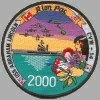 | 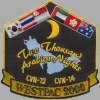 | 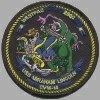 |  |  |
 |  | Click here to view more ABRAHAM LINCOLN Patches. | ||
Accidents aboard USS ABRAHAM LINCOLN:
| Date | Where | Events |
|---|---|---|
| July 27, 1989 | Newport News Shipbuilding, Va. | About 300 gallons of coolant water from the ABRAHAM LINCOLN spill into the James River while the ship is docked at Newport News Shipbuilding. A shipyard spokesman terms the amount of radioactivity released as "minuscule". |
| November 10, 1990 | A damaged landing gear forces a S-3A Viking aircraft to conduct an emergency landing on the flight deck using the crash barricade. Click here for a photo sequence of the landing. | |
| June 29, 1991 | South China Sea | Two F-14A ("201" and "205") of VF-213 are involved in a mid-air collision. One F-14 ("201") crashed into the sea, the crew was rescued, and the other aircraft diverted to Singapore. |
| July 8, 1991 | off Sri Lanka | An F-14A ("203") of VF-213 crashed into the sea, the crew was rescued by a helicopter of HS-6. |
| July 9, 1991 | Indian Ocean | Partial ejection aboard an A-6E of VA-95. The navigator remained 6 minutes halfway outside the canopy in the air stream until the pilot managed to land the aircraft aboard USS ABRAHAM LINCOLN. The navigator survived. Click here for a detailed report of the accident including pictures and sound files. |
| August 24, 1991 | Persian Gulf | An F/A-18 ("304") of VFA-94 crashed into the sea after catapulted off the deck. The pilot ejected and was rescued shortly afterwards. Initially, a cold cat was thought to be the reason for the accident. After the incident it was found that the aircraft had an engine failure which was believed to be caused by FOD at the time of launch. The "fodded" engine blew scrapnel into the other engine. Both engines failed and the plane crashed into the ocean after the cat launch. |
| July 20, 1993 | Indian Ocean | An F-14 of VF-213 crashes on the flight deck whiel attempting to land aboard the ABRAHAM LINCOLN. The aircraft skids across the flight deck, with the majority of the plane ending up in the water. The pilot is killed in the accident while the Radar Intercept Officer is recovered with minor injuries. The carrier suffers minimal damage. |
| September 8, 1993 | Persian | Two A-6 of VA-95 are lost after a mid-air collision over the northern Persian Gulf while both aircraft were returning to the ABRAHAM LINCOLN after a routine patrol mission. All four crew are recovered safely. |
| October 25, 1994 | Pacific | Lieutenant Kara S. Hultgreen, the first woman to fully qualify as an 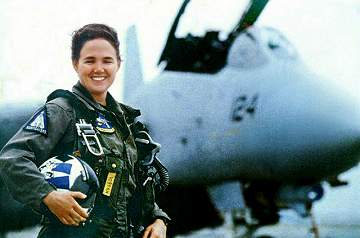 |
| January 28, 1995 | off southern California | During a Fleet Exercise in the SOCAL area of operations, a F/A-18 of VFA-22 crashes shortly after launching from ABRAHAM LINCOLN. The pilot is killed in the accident. |
| February 15, 1995 | off southern California | During Joint Task Force Exercise 1995, a A-6 from VA-95 catches fire while at tension on the catapult. Both crewmembers are able to escape unharmed. |
| April 27, 1995 | western Pacific | An F-14A from VF-213 crashes during a routine mission. Pilot and RIO are recovered safely. |
| June 5, 1995 | Persian Gulf | USS ABRAHAM LINCOLN and the USS SACRAMENTO (AOE 1) collide during an underway replenishment. The LINCOLN is able to continue on her mission while the SACRAMENTO is heading for Jebel Ali, U.A.E., for several days of repairs. |
| September 20, 1995 | central Pacific | An F-14A from VF-213 crashes during a routine mission. Pilot and RIO are recovered safely. |
| December 4, 1996 | eastern Pacific | An F/A-18 from VMFA-314 crashes (ramp strike) during night flight deck certification on sea trials. The pilot safely ejects onto the flight deck and the plane is lost. No other injuries. |
| September 29, 2000 | Persian Gulf | Lt. Bruce Joseph Donald of Poughkeepsie, N.Y., was killed when his |
| August 9, 2019 | 5th Fleet AOR | An E-2D aircraft assigned to VAW-121 strikes two F/A-18 Super Hornets on the flight deck while trying to land aboard the ABRAHAM LINCOLN. Debris from the accident further damage two other Super Hornets parked on the flight deck. The E-2D was able to go-around after the bolter (all arresting cable were missed) and divert to an undisclosed airport. No injuries were reported. |
USS ABRAHAM LINCOLN Image Gallery:
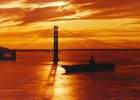 | 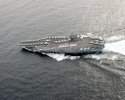 | 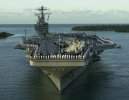 | 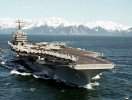 | 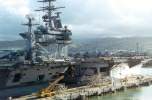 |
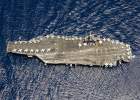 |  | 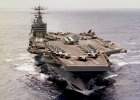 | Click here to view more photos. | |
The photo below was taken by Ian Johnson on January 14, 2003, and shows the ABRAHAM LINCOLN in Gage Roads, Fremantle, Australia. This was the carrier's fourth visit to Fremantle and the longest visit to the city (January 6-19) by any US Navy aircraft carrier because the stay was used for routine maintenance (primarily preservation of the flight deck).
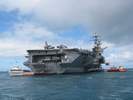 |
The photos below were taken by me on July 27, 2006 (the first 3 photos) and on July 29, 2006, and show the ABRAHAM LINCOLN at Pearl Harbor, HI., after her participation in RIMPAC 2006. The LINCOLN visited Pearl Harbor July 26 - 29.
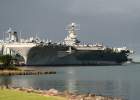 | 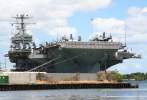 | 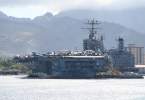 | 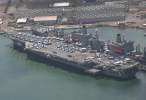 | 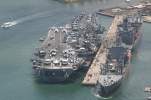 |
The photo below was taken by me on March 13, 2010, and shows the ABRAHAM LINCOLN at Everett, Wash.
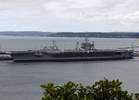 |
The photos below were taken by Michael Jenning and show the ABRAHAM LINCOLN at Naval Base Norfolk, Va., on September 21, 2018.
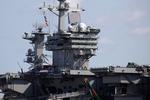 | 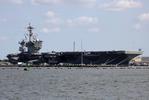 | 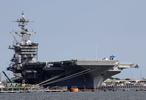 | 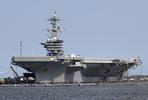 | 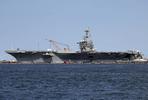 |
The photos below were taken by Michael Jenning and show the ABRAHAM LINCOLN at Naval Air Station North Island, Calif., on December 28, 2021. On January 3, 2022, ABRAHAM LINCOLN departed San Diego on a scheduled deployment.
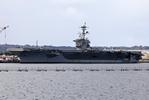 |  | 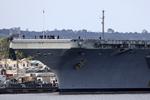 | 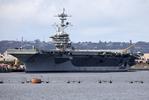 | 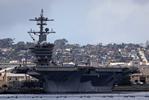 |
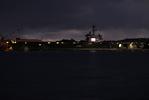 |
 Back to Carriers list.
Back to Carriers list.  Back to ships list.
Back to ships list.  Back to selection page.
Back to selection page.  Back to 1st page.
Back to 1st page.